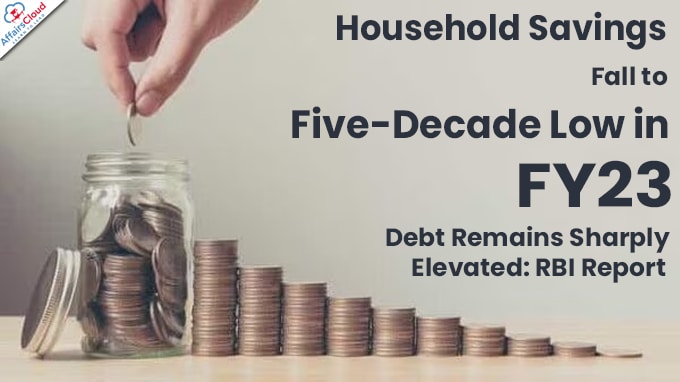 Net financial savings of households declined to a nearly 5-decade low of 5.1% GDP in FY23. This marked a notable decrease from the previous fiscal year, where it stood at 7.2% (FY22), as per RBI data.
Net financial savings of households declined to a nearly 5-decade low of 5.1% GDP in FY23. This marked a notable decrease from the previous fiscal year, where it stood at 7.2% (FY22), as per RBI data.
- National Financial Switch (NFS) usage was decreased from 11.5% in FY21 to 5.1% in FY23, as per data from RBI’s Flow of Financial Assets and Liabilities of Household released on September 2023.
i.Rising Financial Liabilities:
Household financial liabilities saw a substantial increase, rising to 5.8% of GDP in FY23, up from 3.8% in FY22. This indicates that households have increasingly relied on borrowing to meet their consumption needs.
Note: The rate of increase in financial liabilities in FY23 was the second highest since Independence. The highest rate of increase was recorded in FY 2006-07 at 6.7%.
ii.Household Asset Trends:
Net household assets showed a declining trend:
FY21: Rs 22.8 trillion
FY22: Rs 16.96 trillion
FY23: Rs 13.76 trillion
iii.High Household Debt: Household debt remained elevated at 37.6% of GDP in FY23, compared to 36.9% in FY22.
Factors Contributing to Challenging Household Financial Landscape in India:
- Stagnant Wages: Real wages in India have not grown significantly over the past 8 years.
- Increasing Healthcare and Education Costs: The cost of healthcare and education has been steadily increasing, with medical inflation at 12% in 2021, the highest in Asia, and education costs rising by 11-12%.
Note: In a deviation from the usual pattern, private consumption final expenditure (PFCE) saw a year-on-year improvement of 6% in Q1FY24, surpassing 2.8% in Q4FY23 and 2.2% in Q3FY23, possibly influenced by reduced inflation. GDP data for Q1FY24 indicated that investment showed greater strength than consumption, and urban demand surpassed rural demand.
RBI Imposes Penalties on Four Cooperative Banks
Reserve Bank of India (RBI) imposes monetary penalties on four cooperative banks citing its authority under the Banking Regulation Act, 1949, specifically Section 47 A (1) I in conjunction with Sections 46 (4) (i) and 56.
Lalbaug Cooperative Bank Ltd (Gujarat) – Rs 5 Lakh.
Reason: Non-compliance with the RBI directions on ‘Placement of Deposits with Other Banks’ and ‘Interest Rate on Deposits Directions, 2016’.
- Breached prudential inter-bank exposure limit and counterparty exposure limit.
- Failed to pay interest on overdue recurring and term deposits.
Cooperative Bank of Mehsana Ltd (Gujarat) – Rs 3.50 Lakh
Reason: Non-compliance with RBI directions on ‘Loans and Advances to Directors etc. – Directors as surety or guarantors – Clarification’ and ‘Placement of Deposits with Other Banks’.
- Sanctioned loans with a relative of one of the directors as guarantor.
- Breached the inter-bank counterparty exposure limit.
Harij Nagrik Sahakari Bank Ltd (Gujarat) – Rs 3 Lakh
Reason: Non-compliance with RBI directions on ‘Maintenance of Cash Reserve Ratio (CRR)’, ‘Placement of Deposits with Other Banks’, and ‘Interest Rate on Deposits – Directions, 2016’.
- Breached the inter-bank counterparty exposure limit.
- Failed to pay applicable interest on deposits of deceased individual depositors or sole proprietorship concerns.
National Cooperative Bank Ltd (Maharashtra) – Rs 1 Lakh
Reason: Non-compliance with RBI directions on Maintenance of Deposit Accounts-Primary (Urban) Co-operative Banks’.
- Did not conduct annual reviews of inoperative accounts.
RBI in News:
i.The Reserve Bank of India (RBI) had announced on September 8 to phase out the Incremental-cash reserve ratio (I-CRR) by October 7, 2023. As part of this process, 25 percent of the total I-CRR released on September 19, another 25 percent on September 23, and the remaining 50 percent on October 7.
ii.The RBI has issued a list of 15 Non-Banking Finance Companies (NBFCs) categorized in the ‘upper layer’ subject to scale-based regulations.
iii. The RBI has projected a real GDP growth rate of 7.8% for the Q1FY24 and a full-year growth rate of 6.5%.
About Reserve Bank of India (RBI):
Governor– Shaktikanta Das
Headquarters– Mumbai, Maharashtra
Established – April 1, 1935




